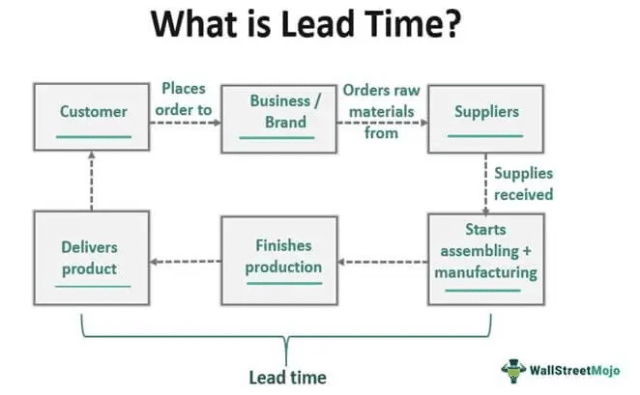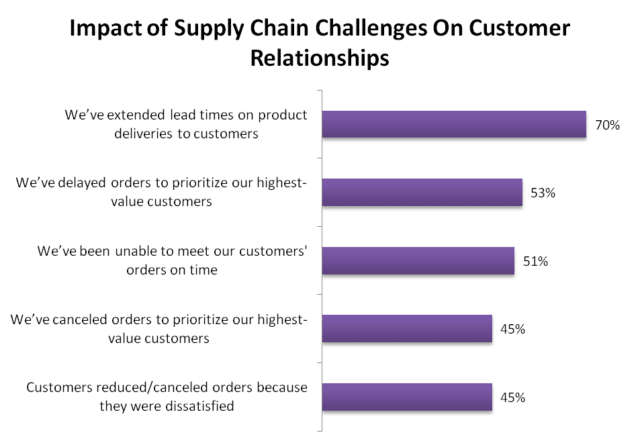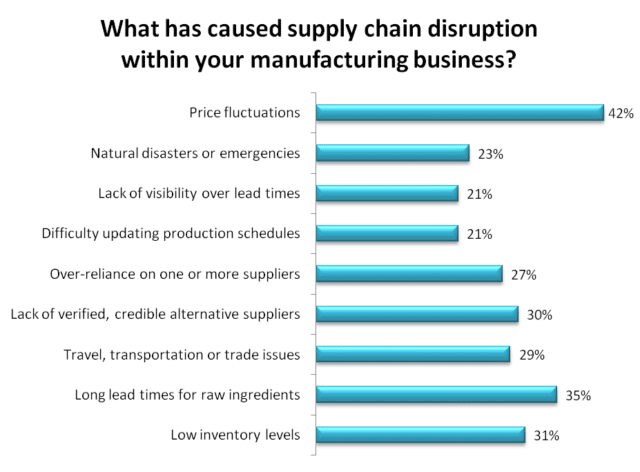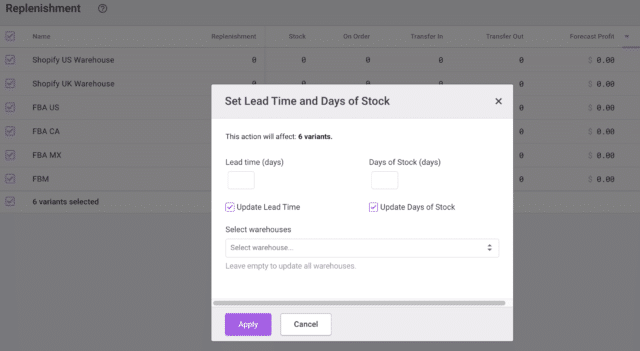Good supply chain management is essential for the efficient operation of your business. You need the right products in the right place at the right time and in the correct amounts to meet demand and maximize sales. Otherwise, you’ll have unhappy customers and revenue loss.
To ensure your supply chain runs smoothly and doesn’t have any bottlenecks, you should track key performance indicators. Lead time is one KPI that can help you identify inefficiencies and improve productivity. In this article, we’ll look at what lead time is, why it’s important, and how you can manage it with Inventory Planner.
What is lead time?
First, let’s define lead time. In general, the lead time definition is the amount of time from the start of a process till its end. Lead time meaning varies according to industry and context. What does lead time mean in manufacturing? In this case, lead time is how long it takes to make and deliver a product to the customer. It includes sourcing, production, and delivery.
What is lead time in purchasing? Lead time in purchasing is the time from placing a purchase order until the order reaches the warehouse. Inventory lead time depends on supplier lead time – the more suppliers there are, the longer the lead time will be. Other types of lead time are:
- Customer lead time: the time it takes to fulfill a customer order
- Material lead time: how long it takes raw materials to reach the warehouse after placing an order
- Production lead time: the amount of time it takes to produce products after receiving an order
- Cumulative lead time: the total time the process takes, from pre-processing to production and delivery

Image Source
Many factors affect lead time, including shipping time, material or labor shortages, and natural disasters. In turn, lead time affects all stages of the supply chain. So, you need to know the lead time of each step in your supply chain.
You also need to understand the lead time economics definition. This includes development costs, manufacturing or operating costs, and delivery costs.
Your optimal lead time isn’t always the shortest; it’s the one that gives you the best value and quality.
In this article, we’ll focus on purchasing lead time, which is crucial for retailers when it comes to planning purchasing and replenishment.
How does lead time impact your purchasing/replenishment process?
If supplier lead time increases, it affects your purchasing and replenishment cycle as you have to wait longer for materials. In fact, 35% of manufacturers say a long lead time for raw ingredients has caused supply chain disruption.
This then increases your lead time, which ultimately impacts your cash flow and your customers. For instance, 70% of manufacturers have had to extend product delivery times because of supplier delays.

Data Source
Lead time is critical in purchasing and replenishment as any changes in lead time could cause stockouts or overstock, which are both costly. If you run out of stock, you miss out on sales and risk overselling, which leads to unhappy customers. If you’re left with overstock, you have cash tied up in inventory, which can’t be reinvested in more profitable areas, as well as less warehouse space for newer inventory. So it’s essential your lead time is predictable and always updated.
Purchasing lead time calculator
The purchasing lead time formula you use depends on the context.
To calculate purchasing lead time for the assembly of a product, you need to take into account different components. So the overall purchasing lead time takes into account the lead time of each component plus assembly time.
For instance, a wardrobe consists of wood, iron bars, and a mirror.
Lead time for each component:
Wood = five days
Iron bars = four days
Mirror = two days
Assembly time = two days
Therefore, for a wardrobe, the lead time for the finished product is five days, which is the longest lead time of a single component of the wardrobe, plus two days for assembly time. So, the total lead time for a wardrobe is seven days.
Longer lead times should be expected for products that require complex components or a large number of components. Remember to take this, as well as the time it takes for the procurement of each component, into account when it comes to project management and inventory management.
Now, let’s find out how to calculate purchasing lead time for bundles. Here, the same principle is used as for calculating purchasing lead time for the assembly of a product, except a bundle doesn’t need to be assembled. So, no assembly time needs to be included in the calculation.
A bundle is usually products that are sold together. For instance, a cosmetics gift bundle could include one eye cream, one face cream, and one bottle of perfume. These require no assembly time.
You can use an online lead time calculator to calculate lead times automatically and eliminate the risk of human error. You can also use online calculators to calculate the total and average lead times.
It’s important to take the lead time into account when replenishing goods as you need to make sure the goods on purchase arrive before your current stock runs out.

Image Source
Identifying bias in lead time demand forecast
58% of businesses say they’ll focus on improving planning and forecasting to manage lead time in supply chains. One such forecasting method is lead time demand forecasting. Lead time demand measures customer demand for a product during a company’s lead time. Forecasting lead time demand can help businesses:
- Plan production schedule and capacities
- Manage their portfolio
- Prevent stockouts and overstocking
But forecasting can be biased, so you may overestimate or underestimate lead time demand. Luckily, you can use a lead time demand formula to calculate forecast bias. An example is the tracking signal:
Tracking signal = Actual demand – Forecast demand/Mean Absolute Deviation
The Mean Absolute Deviation (MAD) is the average distance between each value and the dataset average. A positive result suggests under-forecast, a value of zero indicates no bias, and a negative result suggests over-forecast.
Once you calculate bias, you can adjust the forecast accordingly.
7 Best Practices for Lead Time Optimization and Reduction
A short purchasing lead time has many benefits, including:
- Less cash tied up in inventory
- Greater productivity, allowing you to outpace your rivals
- Less waste from overstock
- Lower carrying costs
- Greater flexibility in the face of market shifts
- Higher profits
So, let’s look at seven ways to optimize and reduce lead time for your business.
1. Better agreements with suppliers
On average, 21% of manufacturers cite lack of visibility over lead times as the cause of supply chain disruption. So, you should include lead time in your supplier contract to ensure both you and the supplier can plan accordingly. The contract should include:
- Lead time for each product or shipment
- Penalties for late or damaged items
- A requirement to give advance notice of price changes, discontinuations, or stock shortages
- Relevant metrics to help the supplier stay on track

Data Source
2. Use a local supplier
If you’re looking at how to reduce lead time, one method is to use local suppliers. Overseas suppliers may be cheaper, but they also have a longer delivery lead time due to shipping time. Overseas lead times are less predictable and more prone to disruptions like natural disasters. Plus, the cost of shipping has skyrocketed in recent years.
Locally sourced products and materials can speed up the production process and increase order frequency. This lowers your transport costs and increases sales, which, in turn, boosts customer satisfaction.
3. Balance supplier fees and lead time
When choosing a supplier, the overall value is more important than the cost of each item. Sometimes, a supplier can be a bit more expensive than others. But if their lead time is X times shorter, it could be more cost-effective as you save much more time on waiting times and reduce the quantity you order each time, leading to less cash tied up in inventory. So, choosing lead time over unit price can save you money in the long term.
4. Use the kitting process
Kitting is another great way to optimize lead time. It involves consolidating related products into a single bundle. For example, instead of packing and shipping individual items to a customer, you could group items into a “kit” with a single SKU number. This saves on shipping costs and makes it easier to log and track the customer’s order.
You can also use kitting to reduce your process lead time by grouping components you often use together in your warehouse. Workers will spend less time gathering parts, which increases their efficiency.
5. Offer an incentive
As we said earlier, you can include penalties for late delivery in your supplier contract. But you could also offer an incentive, like a financial bonus, for delivering early. Suppliers may not be able to change their lead time, but there’s no harm in asking. And a juicy incentive can be a powerful motivator.

Image Source
6. Consider different vendors for different types of products or different warehouse locations
On average, 27% of manufacturers say over-reliance on one or more suppliers disrupts their supply chain. Businesses should always have one or two backup suppliers to reduce disruption and keep lead times consistent.
This is vital if you use a just-in-time (JIT) approach to managing your inventory. After all, since JIT aims to minimize inventory levels, a delay could result in stockouts and angry customers.
7. Review lead times frequently by vendors and warehouses
You should put in place standard guidelines to assess each supplier’s performance. This includes both prospective and current suppliers. If a supplier consistently overruns their order lead time, it’s probably time to look elsewhere. This is another reason it’s important to include lead time in the contract; it’s a legitimate reason to cut ties.
Before changing suppliers, make sure you have a new supplier lined up. Also, you’ll need enough inventory to last until your new supplier delivers their first shipment.
The perfect example of lead time
Let’s say Company A is hosting a three-day event in one week’s time, and they want branded T-shirts to give to the attendees. They estimate 5,000 people will attend the event, so they put in a purchase order for 5,000 T-shirts from Company B. But Company B has a product lead time of two weeks, which means the T-shirts arrive a week after the event.
In this example, Company A failed to consider lead time, so they ended up with 5,000 T-shirts they couldn’t use. If they had considered lead time, they could have ordered the T-shirts from Company C, which has a lead time of five days. That way, the T-shirts would have arrived with two days to spare.
Inventory purchasing lead time

As we said earlier, inventory purchasing lead time is the time it takes to replenish an item, i.e., the time from when a purchase order is placed with a supplier to when the goods arrive in the warehouse. Why is purchasing lead time so crucial? There are several reasons, including:
- Accurately plan your inventory
The lead time helps you determine when you need to replenish goods to make sure the new inventory will arrive before the current inventory runs out. So you won’t have any missed revenue due to stockouts or unhappy customers who can’t get their orders quickly.
- Flexibility in replenishment
If the lead time is short, you can be more flexible with your inventory purchasing cycles. Also, when the lead time is lengthier, you need to predict longer-term customer demand, which is more challenging, and you have more chance of going wrong. Therefore, a shorter lead time will allow you to be agile when customer demand shifts as well.
- Cash flow
The longer the lead time is, the longer your cash is immobilized in inventory on purchase. You can’t capitalize the cash tied up in inventory that is still being delivered to you. That’s why it’s important to look at each of your suppliers’ lead time to each of your warehouses or inventory locations. It can be beneficial to shorten the distance between your suppliers and your warehouses.
Take advantage of Inventory Planner to cover your lead time
Online demand forecasting and inventory planning software, like Inventory Planner, is a great way to manage lead time in your purchasing and replenishment to avoid any stockout or overstock. With Inventory Planner, you can:
- Benefit from high-accuracy demand forecasting based on sales history, factoring in lead time, stockout times, and seasonality
- Get replenishment recommendations to meet customer demand
- Forecast demand for individual or multiple warehouses and inventory locations
- Check and adjust lead times to ensure the right amount of stock is in place before the next purchasing round
- Check supplier requirements so that orders are processed smoothly
- Adjust forecasts to account for promotions and other expected demand peaks
- Create purchase orders in just a few clicks
- Adjust lead time by vendor, warehouse, variant, and assembly
Lead time FAQs
1. Is lead time the same as cycle time?
No, they aren’t the same thing. Cycle time is part of lead time and is the amount of time it takes to complete a task, like creating a product.
2. Does cycle time include pre-production and post-production stages in manufacturing?
No, cycle time excludes pre-production and post-production stages.
3. How is cycle time calculated?
Cycle time = production time/number of products
4. What does lead time mean in shipping?
Delivery lead time is the period between when an order is placed and when that order is delivered.
5. Lead time formulas
Lead Time (LT) = Order Delivery Date – Order Request Date